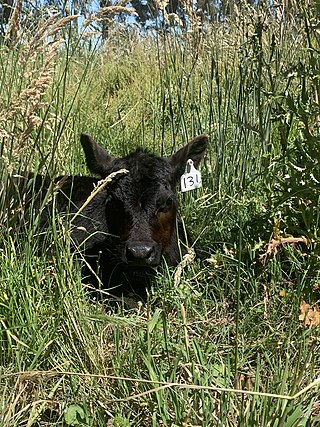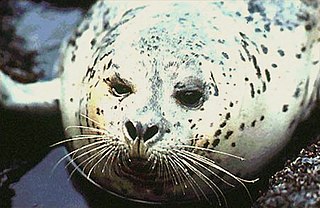
A calf is a young domestic cow or bull. Calves are reared to become adult cattle or are slaughtered for their meat, called veal, and their hide.

The earless seals, phocids, or true seals are one of the three main groups of mammals within the seal lineage, Pinnipedia. All true seals are members of the family Phocidae. They are sometimes called crawling seals to distinguish them from the fur seals and sea lions of the family Otariidae. Seals live in the oceans of both hemispheres and, with the exception of the more tropical monk seals, are mostly confined to polar, subpolar, and temperate climates. The Baikal seal is the only species of exclusively freshwater seal.

Pinnipeds, commonly known as seals, are a widely distributed and diverse clade of carnivorous, fin-footed, semi-aquatic, and mostly marine mammals. They comprise the extant families Odobenidae, Otariidae, and Phocidae, with 34 extant species and more than 50 extinct species described from fossils. While seals were historically thought to have descended from two ancestral lines, molecular evidence supports them as a monophyletic lineage. Pinnipeds belong to the clade Caniformia of the order Carnivora; their closest living relatives are musteloids, having diverged about 50 million years ago.

The Steller sea lion is a large, near-threatened species of sea lion, predominantly found in the coastal marine habitats of the northeast Pacific Ocean and the Pacific Northwest regions of North America, from north-central California to Oregon, Washington and British Columbia to Alaska. Their range continues across the Northern Pacific and the Aleutian Islands, all the way to Kamchatka, Magadan Oblast, and the Sea of Okhotsk, south to Honshu’s northern coastline. It is the sole member of the genus Eumetopias, and the largest of the so-called eared seals (Otariidae). Among pinnipeds, only the walrus and the two species of elephant seal are bigger. The species is named for the naturalist and explorer Georg Wilhelm Steller, who first described them in 1741. Steller’s sea lions have attracted considerable attention in recent decades, both from scientists and the general public, due to significant declines in their numbers over an extensive portion of their northern range—notably in Alaska.

The grey seal is found on both shores of the North Atlantic Ocean. In Latin Halichoerus grypus means "hook-nosed sea pig". It is a large seal of the family Phocidae, which are commonly referred to as "true seals" or "earless seals". It is the only species classified in the genus Halichoerus. Its name is spelled gray seal in the US; it is also known as Atlantic seal and the horsehead seal.

The northern elephant seal is one of two species of elephant seal. It is a member of the family Phocidae. Elephant seals derive their name from their great size and from the male's large proboscis, which is used in making extraordinarily loud roaring noises, especially during the mating competition. Sexual dimorphism in size is great. Correspondingly, the mating system is highly polygynous; a successful male is able to impregnate up to 50 females in one season.

Elephant seals are very large, oceangoing earless seals in the genus Mirounga. Both species, the northern elephant seal and the southern elephant seal, were hunted to the brink of extinction for oil by the end of the 19th century, but their numbers have since recovered. They are the largest extant carnivorans, weighing up to 5,000 kilograms (11,000 lb). Despite their name, elephant seals are not related to elephants, and the large proboscis or trunk that males have was convergently evolved.

The hooded seal is a large phocid found only in the central and western North Atlantic, ranging from Svalbard in the east to the Gulf of St. Lawrence in the west. The seals are typically silver-grey or white in color, with black spots that vary in size covering most of the body. Hooded seal pups are known as "blue-backs" because their coats are blue-grey on the back with whitish bellies. This coat is shed after 14 months of age when the pups molt. It is the only species in the genus Cystophora.

The harp seal, also known as Saddleback Seal or Greenland Seal, is a species of earless seal, or true seal, native to the northernmost Atlantic Ocean and Arctic Ocean. Originally in the genus Phoca with a number of other species, it was reclassified into the monotypic genus Pagophilus in 1844. In Greek, its scientific name translates to "ice-lover from Greenland," and its taxonomic synonym, Phoca groenlandica translates to "Greenlandic seal." This is the only species in the genus Pagophilus.

The subantarctic fur seal is a species of arctocephaline found in the southern parts of the Indian, Pacific, and Atlantic Oceans. It was first described by Gray in 1872 from a specimen recovered in northern Australia—hence the inappropriate specific name tropicalis.

The Juan Fernández fur seal is the second smallest of the fur seals, second only to the Galápagos fur seal. They are found only on the Pacific Coast of South America, more specifically on the Juan Fernández Islands and the Desventuradas Islands. There is still much that is unknown about this species. Scientists still do not know the average life span of this species, or the diet and behavior of males apart from the breeding season.

The Galápagos fur seal is one of eight seals in the genus Arctocephalus and one of nine seals in the subfamily Arctocephalinae. It is the smallest of all of the eared seals. They are endemic to the Galápagos Islands in the eastern Pacific. The total estimated population as of 1970 was said to be about 30,000, although the population has been said to be on the decline since the 1980s due to environmental factors such as pollution, disease, invasive species, and their limited territory. Due to the population having been historically vulnerable to hunting, the Galápagos fur seal has been protected by the Ecuadorian government since 1934

The brown fur seal, also known as the Cape fur seal, South African fur seal and Australian fur seal, is a species of fur seal.

The South American sea lion, also called the southern sea lion and the Patagonian sea lion, is a sea lion found on the western and southeastern coasts of South America. It is the only member of the genus Otaria. The species is highly sexually dimorphic. Males have a large head and prominent mane. They mainly feed on fish and cephalopods and haul out on sand, gravel, rocky, or pebble beaches. In most populations, breeding males are both territorial and harem holding; they establish territories first and then try to herd females into them. The overall population of the species is considered stable, estimated at 265,000 animals.

Arctocephalus forsteri is a species of fur seal found mainly around southern Australia and New Zealand. The name New Zealand fur seal is used by English speakers in New Zealand; kekeno is used in the Māori language. As of 2014, the common name long-nosed fur seal has been proposed for the population of seals inhabiting Australia.

Phoca is a genus of the earless seals, within the family Phocidae, source of the French name for seal, 'phoque'. It now contains just two species, the common seal and the spotted seal. Several species formerly listed under this genus have been split into the genera Pusa, Pagophilus, and Histriophoca. Until recently, Phoca largha has been considered a subspecies of Phoca vitulina but now is considered its own species. For this reason, the fossil history of the genus is unclear, and it has formerly been used as wastebasket taxon for a number of fossils of uncertain affinity.

The ribbon seal is a medium-sized pinniped from the true seal family (Phocidae). A seasonally ice-bound species, it is found in the Arctic and Subarctic regions of the North Pacific Ocean, notably in the Bering Sea and Sea of Okhotsk. It is distinguished by its striking coloration, with two wide white strips and two white circles against dark brown or black fur.

The southern elephant seal is one of two species of elephant seals. It is the largest member of the clade Pinnipedia and the order Carnivora, as well as the largest extant marine mammal that is not a cetacean. It gets its name from its massive size and the large proboscis of the adult male, which is used to produce very loud roars, especially during the breeding season. A bull southern elephant seal is about 40% heavier than a male northern elephant seal, which is nearly twice the weight of a male walrus, or 6–7 times heavier than the largest living mostly terrestrial carnivorans, the Kodiak bear and the polar bear.
Tagging of Pacific Predators (TOPP) began in 2000 as one of many projects formed by Census of Marine Life, an organization whose goal is to help understand and explain the diversity and abundances of the ocean in the past, present, and future. After they were formed, TOPP began by building a coalition of researchers from all over the world to find and study predators of the Pacific Ocean. Since then, they have satellite-tagged 22 different species and more than 2,000 animals. These animals include elephant seals, great white sharks, leatherback turtles, squid, albatrosses, and more.

The harborseal, also known as the common seal, is a true seal found along temperate and Arctic marine coastlines of the Northern Hemisphere. The most widely distributed species of pinniped, they are found in coastal waters of the northern Atlantic and Pacific oceans, Baltic and North seas.




















